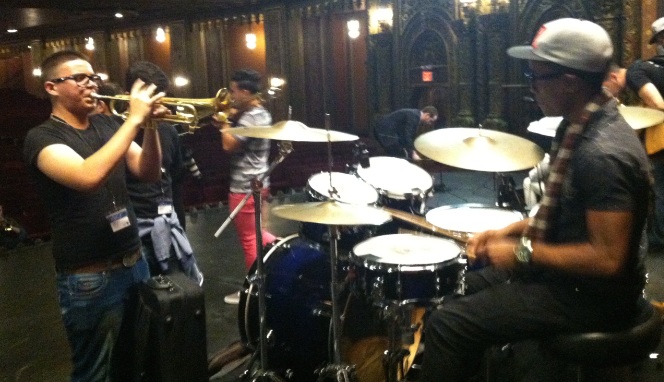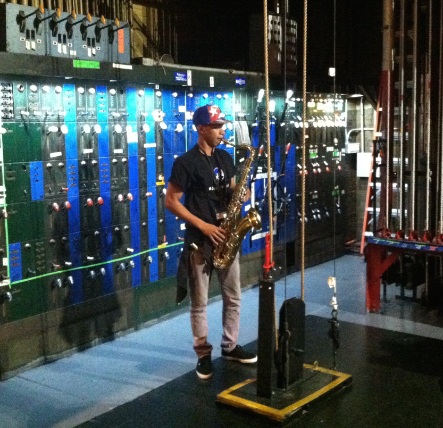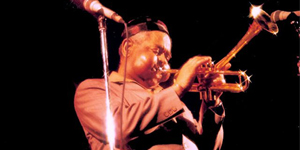Afro-Cuban culture, Blog, Cuba, Cuban Jazz, Latin Jazz, The Cuba-US connection, Video and audio
Cándido de Guerra Camero (“Candido”) was born April 22, 1921 in Cuba.
At the time of this writing (June 22, 2016) you can still see him perform.
If you get the chance, do not miss it.
At 95, he needs a little help to get to his seat and drums, but from the first slap the power resonates from him and fills the room.
In the 1940s like so many Cuban music masters he moved to New York City where he has had an incalculable influence on the world of percussion and in fact is the most recorded conga drummer in the history of jazz.
Candido shows his prowess on the bass and the cowbell. No one sets a better groove!
Candido swings with some young cats…
The band is Unity. Recorded by Congahead .
Candido Camero-conga
Axel Laugart-keyboard
Amaury Acosta-drums
Max Cudworth-alto sax
Mike Rodriguez-trumpet
Chris Smith-bass
Michael Valeanu-guitar
Mauricio Herrera-percussion
Composed by- Candido Camero
Arranged by Amaury Acosta/Mike Rodriguez
– Ken McCarthy
Jazz on the Tube
P.S. Our unique programming is made possible by help from people like you. Learn how you can contribute to our efforts here: Support Jazz on the Tube
Thanks.
Afro-Cuban culture, Blog, Cuba, Cuban Jazz, Latin Jazz
TECHNICAL NOTE: It’s not your eyes. This is an hazy, old piece of video.
It’s one of the great mysteries of music history.
Israel López Valdés (“Cachao”) was born in September 14, 1918 in Havana, Cuba.
Less than a month later, Jimmy Blanton was born on October 5, 1918 in Chatanooga, Tennessee. He died at twenty-four on July 30, 1942.
Before these two giants came along, no one played the bass this way. Cachao in Cuba and Blanton in the US completely revolutionized the instrument.
Blanton opened the doors for people like Charles Mingus, Ray Brown, Paul Chambers, and so many other great artists and Cachao changed the sound of Latin music.
Did they know each other? Did they ever have occasion to hear each other’s music?
From my analysis, while it’s possible, both artists had already created their respective styles before their recordings would have made it to each other’s countries.
What stars were in the sky when these two were born?
The interview video was copied off TV in Miami on the 1990s. Thanks goodness someone had the presence of mind to interview Cachao and thanks to Rick Camara for posting it.
Now Cachao in action…
Cachao & Paquito D’Rivera
– Ken McCarthy
Jazz on the Tube
P.S. Our unique programming is made possible by help from people like you. Learn how you can contribute to our efforts here: Support Jazz on the Tube
Thanks.
Afro-Cuban culture, Blog, Cuba, Cuban Jazz, Latin Jazz, Video and audio
“Irakere” is a Yoruban word that means virgin forest, a wild place unspoiled by civilization.
Tracking this band, its history, evolution and personnel changes would take a web site all by itself.
A short version of their story:
Jazz was not smiled upon by the government in Cuba in the 60s and 70s. The powers that be felt it smacked of imperialism and capitalism.
However, in order to cater to visitors and their expectations, the government underwrote a group called Orquesta Cubana de Música Modern that played American music.
In 1973, members of the Orquesta broke away to form Irakere. The founders included pianist Chucho Valdés, saxophonist Paquito D’Rivera, trumpet player Jorge Varona, guitarist Carlos Emilio Morales, bassist Carlos del Puerto, drummer Bernardo García, and percussionist and singer Oscar Valdés II.
In 1977, the group performed at two “Iron Curtain” festivals, the Belgrade Jazz Festival and the Warsaw Jazz Jamboree where they had the chance to meet Betty Carter, Mel Lewis and Thad Jones.
Later that year Dizzy Gillespie, Stan Getz, Earl Hines and other American musicians visited Cuba on a “jazz cruise,” the first time jazz musicians visited Cuba since the break in diplomatic and trade relations in 1961. Gillespie and Getz jammed with the members of the band.
In 1980 with Gillespie’s help, the group won spots on at the Newport Jazz Festival in New York City and the Montreux Jazz Festival in Switzerland and their international career was launched.
The recordings of those shows were packaged by both CBS Records (JC-35655) and EGREM (Areíto LD-3769) and won the Grammy in the 22nd Annual Grammy Awards for Best Latin recording.
The concert above was recorded at the Capital Theater in Jersey City, New Jersey on March 23, 1979 in the middle of their commercial break out.
(Make sure you watch through to the end when the group takes the music right into the audience.)
Personnel:
Carlos del Puerto, bass
Carlos Morales, electric guitar
Enrique Pla, drums
Jorge Alfonso El Niño, conga drums
Oscar Valdés, vocal and Cuban percussion
Armando Cuervo, vocal and Cuban percussion
Jorge Varona, trumpet, flugelhorn and vocal
Arturo Sandoval, trumpet, flugelhorn, valve trombone, vocal, arranger
Paquito D’Rivera, flute, alto sax, soprano sax, baritone sax, arranger
Carlo Averoff, soprano sax, tenor sax, flue, piccolo
Chucho Valdés, arranger, composer, keyboards, band leader
We have two more videos from this period.
One from Venezuelan television which we believe was recorded in 1979.
We also have one from 1977 when many of the cats were still in their twenties.
From Venezuelan television – c. 1979
Personnel:
Arturo Sandoval, trumpet
Jorge Varona, trumpet and vocals
Chucho Valdés, keyboards
Carlos Averhoff, saxophone
Carlos del Puerto, bass
Enrique Pla, timbales
Jorge Alfonso El Niño, conga drums, vocals
Armando Cuervo, percussion and vocals
Oscar Valdés, percussionist and vocals
Paquito D’Rivera, not on this recording
Filmed in 1977
– Ken McCarthy
Jazz on the Tube
P.S. Our unique programming is made possible by help from people like you. Learn how you can contribute to our efforts here: Support Jazz on the Tube
Thanks.
Blog, Cuba, Cuban Jazz, Latin Jazz, Video and audio
This one-camera, no-edits video was shot by Al Carmona (Albert P. Camona) at the The University of the Arts of Cuba / Instituto Superior de Arte (ISA) and posted to YouTube in 2006.
ISA was founded September 1, 1976, by the Cuban government as the national school for the arts.
The soloists are:
Jorge Vistel (trumpet)
Regis Molina is described in the YouTube notes as playing “alto sax”, but since the primary saxophone in this performance is a baritone, I’m going to guess that the author meant baritone sax.
The composition “Moanin'” is by Charles Mingus and first appeared on the album “Blues and Roots” recorded on February 4, 1959 at Atlantic Studios in New York City.
– Ken McCarthy
Jazz on the Tube
P.S. Our unique programming is made possible by help from people like you. Learn how you can contribute to our efforts here: Support Jazz on the Tube
Thanks.
Blog, Cuba, Cuban Jazz, Latin Jazz, The Cuba-US connection, Video and audio
Last week we interviewed Jana La Sorte, managing director of Horns to Havana.
Unfortunately, we missed their Jazz at Lincoln Center performance (we’ll post the video if it ever becomes available), but we did make it to their performance the next day at the United Palace of Cultural Arts at 175th Street and Broadway.
The audience were New York City school children ages six to ten, many of them bilingual English and Spanish speakers.
The orchestra played some classic numbers and arrangements by greats like Benny Carter and Glenn Miller. Then they did some Cuban numbers at which point the little ones jumped up and started dancing. This is what it’s all about.

The United Palace really is a palace. A former movie palace built in 1930, it’s been kept in
pristine condition and hosts many cultural events.

We met this young trumpet player David Navarro in Havana and were delighted to see
him again this time playing in New York. His first time out of the country.

Back stage warming up the tenor
– Ken McCarthy
Jazz on the Tube
P.S. Our unique programming is made possible by help from people like you. Learn how you can contribute to our efforts here: Support Jazz on the Tube
Thanks.
Blog, Cuba, Cuban Jazz, Jazz on the Tube Interview, Latin Jazz, People, Producer-Presenters, The Cuba-US connection, Video and audio

Interview
Download the mp3 here
Jazz on the Tube’s Ken McCarthy talks with Jana La Sorte, managing director of Horns to Havana.
This wonderful organization brings much needed musical instruments to Cuba and arranges education and exchange programs for young Cuba musicians.
For more information, click here: Horns to Havana
– Ken McCarthy
Jazz on the Tube
P.S. Our unique programming is made possible by help from people like you. Learn how you can contribute to our efforts here: Support Jazz on the Tube
Thanks.






